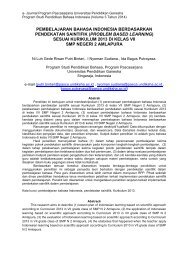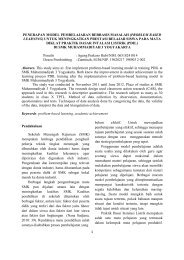You also want an ePaper? Increase the reach of your titles
YUMPU automatically turns print PDFs into web optimized ePapers that Google loves.
Mixtures<br />
Working scientifically:<br />
How theories change<br />
over time<br />
After the discovery of the new element phosphorus in 1649, scientists<br />
began to think about the definition of an element. In 1789 Antoine-Laurent<br />
de Lavoisier produced a table similar to that below of simple substances, or<br />
elements, which could not be broken down further by chemical reactions.<br />
In addition to many elements which form the basis of our modern periodic<br />
table, Lavoisier’s list also included ’light’ and ‘caloric’ (heat) which at<br />
the time were believed to be material substances. Lavoisier incorrectly<br />
classified some compounds as elements because high temperature<br />
smelting equipment or electricity was not available to break down these<br />
compounds. The incorrect classification of these compounds as elements<br />
was due to a lack of technology as much as a lack of knowledge.<br />
Acid-making<br />
elements<br />
Gas making<br />
elements<br />
Metallic elements<br />
Earth elements<br />
Sulfur Light Cobalt mercury, tin Lime (calcium oxide)<br />
Phosphorus Caloric (heat) Copper, nickel, iron Magnesia (magnesium oxide)<br />
Charcoal (carbon) Oxygen Gold, lead, silver, zinc Barytes (barium sulfate)<br />
Azote (nitrogen) Manganese, tungsten Argila (aluminium oxide)<br />
Hydrogen Platina (platinum) Silex (silicon dioxide)<br />
A version of the periodic table hangs<br />
on the wall of almost every chemistry<br />
laboratory across the world – it<br />
summarises much of our knowledge of<br />
chemistry. The history of the periodic<br />
table illustrates how scientifi c theories<br />
change over time.<br />
Questions<br />
1 What is an element?<br />
2 Which elements in Lavoisier’s table also appear in today’s periodic table?<br />
3 Which group of elements did Lavoisier classify correctly?<br />
4 Why do you think sulfur, phosphorus and charcoal are described as<br />
‘acid-making’ elements?<br />
5 Which substances in Lavoisier’s list, from your own modern knowledge, are<br />
compounds? Why do you think Lavoisier thought these were elements?<br />
Following on from the work of Lavoisier, in the early 19th century Johann<br />
Döbereiner noted that certain elements could be arranged in groups of<br />
three because they have similar properties. For example<br />
▶ lithium, sodium and potassium – very reactive metals that produce<br />
alkalis with water<br />
▶ calcium, strontium and barium – reactive metals but with higher melting<br />
points and different formula of their oxides<br />
▶ chlorine, bromine and iodine – low melting point, coloured, reactive<br />
non-metals.<br />
Note: A double-page spread version of this section will be available in the<br />
full version.<br />
27





